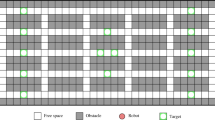Abstract
When multiple robots perform tasks in a shared workspace, they might be confronted with the risk of blocking each other’s ways, which will lead to conflicts or interference among them. Planning collision-free paths for all the robots is a challenge for a multi-robot system, which is also known as the multi-robot cooperative pathfinding problem in which each robot has to navigate from its starting location to the destination while keeping avoiding stationary obstacles as well as the other robots. In this paper, we present a novel fully decentralized approach to this problem. Our approach allows robots to make real-time responses to dynamic environments and can resolve a set of benchmark deadlock situations subject to complex spatial constraints in a shared workspace by means of altruistic coordination. Specifically, when confronted with congested situations, each robot can employ waiting, moving-forwards, dodging, retreating and turning-head strategies to make local adjustments. Most importantly, each robot only needs to coordinate and communicate with the others that are located within its coordinated network in our approach, which can reduce communication overhead in fully decentralized multi-robot systems. In addition, experimental results also show that our proposed approach provides an efficient and competitive solution to this problem.









Similar content being viewed by others
Notes
It is also possible that robot r may generate a new shortest path at the moment, according to which it does not have to go backwards.
BW4T introduced in [6] has been integrated into the agent environments in GOAL [5], which can be found from http://ii.tudelft.nl/trac/goal.
References
Bennewitz M, Burgard W, Thrun S (2002) Finding and optimizing solvable priority schemes for decoupled path planning techniques for teams of mobile robots. Robot Auton Syst 41(2):89–99
Burgard W, Moors M, Stachniss C, Schneider FE (2005) Coordinated multi-robot exploration. IEEE Trans Robot 21(3):376–386
Desaraju VR, How JP (2012) Decentralized path planning for multi-agent teams with complex constraints. Auton Robot 32(4):385–403
Dresner K, Stone P (2004) Multiagent traffic management: a reservation-based intersection control mechanism Proceedings of the Third International Joint Conference on Autonomous Agents and Multiagent Systems, pp. 530–537
Hindriks K (2013) The goal agent programming language, http://ii.tudelft.nl/trac/goal
Johnson M, Jonker C, Riemsdijk B, Feltovich P, Bradshaw J (2009) Joint activity testbed: Blocks world for teams (bw4t)
Kaminka GA (2012) Autonomous agents research in robotics: A report from the trenches 2012 AAAI Spring Symposium Series
Luna R, Bekris KE (2011) Efficient and complete centralized multi-robot path planning
Parker LE (2000) Current state of the art in distributed autonomous mobile robotics. In: Distributed Autonomous Robotic Systems 4, pp. 3–12 Springer
Parker LE (2012) Decision making as optimization in multi-robot teams
Ryan MR (2008) Exploiting subgraph structure in multi-robot path planning. J Artif Intell Res 31:497–542
Silver D. (2005) Cooperative pathfinding
Standley T, Korf R (2011) Complete algorithms for cooperative pathfinding problems Proceedings of the Twenty-Second international joint conference on Artificial Intelligence, pp. 668–673
Surynek P (2010) An optimization variant of multi-robot path planning is intractable
Van Den Berg JP, Overmars M.H. (2005) Prioritized motion planning for multiple robots
Wang KHC, Botea A (2008) Fast and memory-efficient multi-agent pathfinding International Conference on Automated Planning and Scheduling (ICAPS), pp. 380–387
Wang KHC, Botea A (2011) Mapp: a scalable multi-agent path planning algorithm with tractability and completeness guarantees. J Artif Intell Res 42(1):55–90
Wei C, Hindriks KV (2013) An agent-based cognitive robot architecture. In: Dastani M, Hbner J, Logan B (eds) Programming Multi-Agent Systems, Lecture Notes in Computer Science , vol. 7837, pp. 54–71. Springer Berlin Heidelberg
de Wilde B, ter Mors AW, Witteveen C (2013) Push and rotate: cooperative multi-agent path planning Proceedings of the Twelfth International Conference on Autonomous Agents and Multiagent Systems, pp. 87–94
uluaga M, Vaughan R (2005) Reducing spatial interference in robot teams by local-investment aggression IEEE/RSJ International Conference on Intelligent Robots and Systems(IROS), pp. 2798–2805
Author information
Authors and Affiliations
Corresponding author
Rights and permissions
About this article
Cite this article
Wei, C., Hindriks, K.V. & Jonker, C.M. Altruistic coordination for multi-robot cooperative pathfinding. Appl Intell 44, 269–281 (2016). https://doi.org/10.1007/s10489-015-0660-3
Published:
Issue Date:
DOI: https://doi.org/10.1007/s10489-015-0660-3




